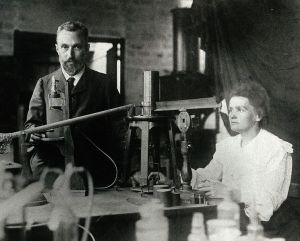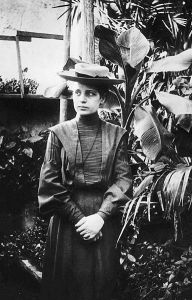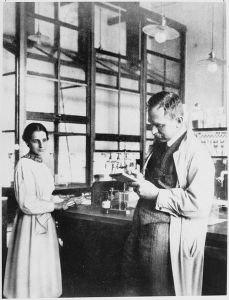SciTech Tuesday: The Women Who Built Manhattan’s Foundation
The Manhattan Project, which was the US effort to build a nuclear bomb during World War II, was one of the largest and most expensive scientific endeavors ever undertaken.
Behind it all was the research of two women—without their important research the work to use and control atomic energy would never have been possible. Their work was the foundation of the Manhattan Project. Both of these women were born in the first week of November, and so we celebrate them today.
Marie Sklodowska was born November 7th 1867 in Poland, to a pair of poor schoolteacher parents. After studying at university in Warsaw she worked as a governess to support her sister’s studies in Paris, eventually earning enough to move to Paris herself. She studied chemistry at the University of Paris, where she met Pierre Curie, a young physicist who had discovered the piezoelectric effect. The two were married in 1895. They worked together in a shed on the campus of the University of Paris. Although Pierre was a professor, they university did not support their research—they funded their work with grants from industry. Marie Curie began a systematic search for elements that were radioactive, having discovered the properties first in samples of Uranium. In 1898 her husband abandoned his own research program to help with hers. Between 1898 and 1902 they published 32 papers, including the observation that radium exposure was more damaging to cancer cells than healthy cells. In 1903 the Nobel Prize in Physics was awarded to Marie Curie, Pierre Curie, and Henri Becquerel, for the discovery of radioactivity. Marie was added to the award only after protest. The Curies used their share of the prize money to hire a research assistant, although they still didn’t have a proper lab. The University of Paris agreed to give Professor Curie (that’s Pierre, Marie was faculty because she was a woman) a lab, but it would not be ready until 1906. About the time that the lab was completed, Pierre was killed in a road accident (rain, horse-drawn wagon, fractured skull).
Marie was devastated by his death. The University of Paris, in a remarkable change of direction, offered her the endowed chair it had established for Pierre. She accepted, and finally with resources to work, she forged ahead. The Pasteur Institute at the University of Paris soon opened a Radium Lab for her to lead. In 1910 she isolated the element Radium, and in 1911 she received the Nobel Prize for Chemistry. She remains one of only two people who have received two Nobels, and is the only person who received two Nobels for science.
During World War I Marie worked to support the French war effort, developing mobile radiography units to travel to the front. Under her direction, 4 more members of the Radium Institute won Nobel Prizes. This included her daughter Irene and son-in-law Frederic. More than science must have been passed down, this pair (named Joliot-Curie) had a long and successful career as spouses and colleagues.
Marie Curie died in 1934, of health problems probably caused by exposure to radiation. In 1995, the French Government, which up to then had an ambivalent attitude towards her, had never noted her war service, and abetted xenophobic talk about her, moved her tomb to the Pantheon, with Pierre beside her.
Lise Meitner was also born on November 7th, but twelve years later and in Austria. Her family was large, middle class, and Jewish. She converted to Lutheranism as an adult in 1908.
In 1905 she received her PhD in Physics from the University of Vienna. Her studies were complicated by the restrictions placed on women at the University. She moved to Berlin and studied with Max Planck alongside Otto Hahn. In 1926 she was named Professor of Physics at the University of Berlin. She worked on the properties of radioactive isotopes at the Kaiser Wilhelm Institute in Berlin. In the 1930s, as her colleagues Fritz Haber and Leó Szilárd, and even her nephew Otto Frisch, escaped Germany, she remained in denial and focused on her work. The Anschluss changed all that, and she fled to Denmark, and then on to Sweden. She got away with no possessions, only a few marks and a diamond ring Hahn gave her in case she needed to bribe someone.
In Stockholm she worked in collaboration with Niels Bohr, and maintained regular correspondence with Hahn and the rest of her colleagues in Germany. Hahn and Fritz Strassman conducted an experiment in which they bombarded Uranium with neutrons. Confused by the results, and how to interpret them, he sent them by letter to Meitner. With her nephew Frisch, she interpreted the results as a splitting of the Uranium atom. She also recognized that Einstein’s famous relativity equation explained the great amount of energy released. In January and February of 1939 the reports of the Hahn-Strassman experiment and Meitner-Frisch interpretation were published.
In 1945 the Nobel Prize in Physics was awarded to Otto Hahn for the discovery of fission in Uranium. The contributions of Meitner and Frisch were ignored.
She worked on the physics of radiation in Sweden until her retirement in 1960, when she moved to England. She died in Cambridge in 1968. Otto Frisch wrote for her headstone “Lise Meitner: a physicist who never lost her humanity.”
Posted by Rob Wallace, STEM Education Coordinator at The National WWII Museum
All photos from Wikimedia Commons







Leave a Reply